

ABOUT BNIM
BNIM is an innovative leader in designing high performance environments. BNIM’s instrumental development of the USGBC, LEED, and the Living Building concept, combined with projects, methods, and research, shaped the direction of the sustainable movement. Through this involvement, the firm has redefined design excellence to elevate human experience together with aesthetics and building performance. In practice, this multifaceted approach to design excellence has yielded national acclaim, including the AIA National Architecture Firm Award, and consistent design recognition nationally and internationally. BNIM is Building Positive, a notion that describes how our practice leverages its collective capacity for design thinking to solve issues at every scale in a way that is focused on building the positive attributes of community and the built environment. Through an integrated process of collaborative discovery, BNIM creates transformative, living designs that lead to vital and healthy organizations and communities.
Libraries
THE PRACTICE OF BNIM

Price Gilbert – Crosland Tower Library Renewal
GEORGIA INSTITUTE OF TECHNOLOGY ATLANTA, GEORGIA

The adaptive reuse of Price Gilbert Memorial Library and Crosland Tower at Georgia Institute of Technology will transform the two campus buildings into the Research Library of the 21st Century. The project is a critical initiative of the institute’s strategic plan and vision for transforming the campus into a knowledge-based community. The transformation is founded on changes in the way that students and faculty currently use the library, as well as future trends in library utilization found on peer campuses across the country. Georgia Tech has conceived of a place where knowledge is not simply stored, but generated.
230,000 SF
Completion in 2018 (Phase 1), 2020 (Phase 2)
 Original Building
Original Building
The Library, Future Tense: A Vision for Georgia Tech’s Research Library of the Twenty First Century
Price Gilbert Memorial Library and Crosland Tower on the Georgia Institute of Technology Campus will be transformed into Georgia Tech’s vision for the Research Library of the Twenty First Century. These before/after pairs illustrate the big ideas of the transformation.



Price Gilbert and Crosland Tower have great value to Georgia Tech as physical assets. The buildings occupy prime real estate at the heart of Georgia Tech’s campus. They comprise 230,000 square feet of non-departmental Institute space. And in the case of Price Gilbert, the midcentury modern design is historically significant. Continuing to invest in the relevance of these buildings means first focusing on renewing core, shell, and building systems. The envelopes of the buildings will be rehabilitated and opened up to daylight wherever possible. The core elements will be upgraded to meet contemporary codes and will provide room for future expansions or modifications. The systems that heat, cool, move water, and light the buildings will be entirely new and very efficient. Taken together, these strategies will drive energy use dramatically downward even as the user population doubles, so that the energy use intensity per person reduces by a factor of almost five.
With circulation of physical library materials trending downward, knowledge is now recorded, stored, and disseminated by digital means. The digital cloud of shared knowledge is overwhelmingly vast. The Library of the 21st Century is a place to make sense of it all. There remains a human desire for the Library to be a physical, tactile, and serendipitous experience that inspires awe. The future Library will do this by taking these digital, invisible resources and manifesting their presence through means that are sometimes pragmatic (as in virtual browsing) and sometimes artistic (as in an abstract installation) Despite demand for digital resources over physical books, the importance of a place to study, collaborate, and explore new learning methods is increasing among students and faculty. The role of the future research library is unique and necessary. It is neutral ground uniting the campus and community that provides global connectedness for collaborative, interdisciplinary and individual learning in ways that no other department or school can provide.
Crosland Tower was purpose built as a stacks building, originally called the annex. Well-suited to house books, it is a robust structure with low floor-tofloor heights and very few windows. With the renewal, the vast majority of books are leaving this facility and being relocated to the Library Services Center, a joint venture between Georgia Tech and Emory University. The resulting void will be transformed into people space. But the characteristics that make Crosland Tower a good storehouse for books need to be turned inside out in order to do so. People require daylight and views; volumetric spaces; and a variety of different space types for different uses, and the renewal will create these spaces.



The two buildings are technically separate structures, but the separation is not so distinct when inside them. A connecting structure obscures the independence of each building and congests an important pedestrian thoroughfare, Cherry Street. The design will reintroduce this artery’s importance as a north/south campus connection by opening up the space between the buildings, connecting them with a light, transparent bridge. Inside the building, the main hub of activity will move one level down from where it currently is. This change will allow Price Gilbert to retain its pristine historic character on the upper levels, and down below will also permit a contiguous, accessible internal connection through Crosland Tower, Price Gilbert, and the recently completed Clough Undergraduate Learning Commons.
Long Life, Loose Fit, as found in AIA COTE’s measure nine, has become one of the strongest principles guiding the design of this project. BNIM’s design intent for the Library Renewal is to create good spaces for people that remain relevant far into the future. Daylight and volume are the basic building blocks that existing Price Gilbert possesses, and are exactly what will be created in Crosland Tower. Crosland Tower floor plates are designed for adaptability as office and user space needs wax and wane. A variety of spaces will be provided — small to large, grand to private. Georgia Tech is continuing to pilot new concepts for delivering service this fall and next spring. And the building design is flexible enough to react to and incorporate the findings of these pilot programs.
The next generation library becomes a place where knowledge is both produced and consumed. Crosland Tower was purposefully designed as an introverted building. The renewal will transform it into an extroverted building – a better reflection of the functions taking place within and of Georgia Tech’s relationship to the knowledge community beyond its walls. The north and south facades of the tower will be removed and replaced with highly transparent, low-iron glass to provide controllable south light and diffuse north light. The east and west facades will be left opaque in response to the harsh east and west sun. New entry points will be created where blank walls exist currently. And Crosland Tower will be crowned at it top level by a large reading room and event space with expansive views of the surrounding city.


AWARDS
Structural Engineers
Association of Georgia
Outstanding Project Award 2020
ENR Southeast (Engineering News Record)
Award of Merit 2019



















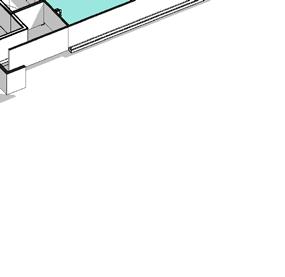

























































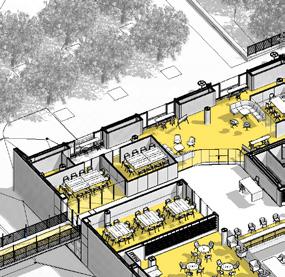




























































































































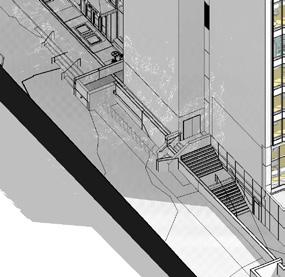







































Price Gilbert Library is a memorable 1953 landmark. Crosland Tower, completed in 1968, is a building originally intended to store books with limited space for students or faculty. In order to accomplish the vision and be respectful of the buildings’ landmark importance, the two buildings were approached differently in terms of architectural design and similarly in terms of human purposed integrated design. The interventions strive to maintain the clarity of the form while connecting the building to the campus and nature where the building touches the landscape, interacting with the sun through the envelope changes and at the roof with the introduction of a new reading room and roof gardens.




WATER USE REDUCTIONS (Gallons per Year)
1,031K BEFORE RENEWAL
97K AFTER RENEWAL

Central to the long-term success of Price Gilbert and Crosland Tower is the concept of “long life, loose fit” — that the ability to address future, unanticipated needs is something that can be designed. Price Gilbert, with its open plan and high-ceilinged reading rooms, is already an exemplar of this mentality; the goal is to capitalize on and retain its adaptable nature while providing for the same at Crosland Tower. The renovation will create spaces that are functional, flexible, and have plentiful daylight and views.
The design team incorporated many sustainable strategies into the design, including chilled beams for cooling and LED lighting throughout the buildings. After the renovation, the population using the buildings will have doubled—the 1,250 seats currently in the buildings will grow to 2,360—yet total energy consumption will be reduced by about a third, and energy consumption per capita will be 80% less than what it is currently.




ENERGY USE PER PERSON (Btu/sf/person)
96.8 BEFORE RENEWAL
19.9 AFTER RENEWAL
Robert E. Kennedy Library Programming and Feasibility Study
CALIFORNIA POLYTECHNIC STATE UNIVERSITY
SAN LUIS OBISPO, CALIFORNIA


The Robert E. Kennedy Library at California Polytechnic State University (Cal Poly) in San Luis Obispo, originally completed in 1980, is heavily utilized by students, faculty, and the surrounding community. In 2016-217, the library received more than 1.5 million visitors, including researchers from around the world who traveled for its archival collections of manuscripts, rare books, architectural drawings, and photographs.
The five-story, 208,433 GSF Brutalist structure is in need of renovation to repair degrading infrastructure, accommodate current and future technology, increase energy and water conservation, and enhance overall functionality and flexibility for the 21st-century student experience.
Working with brightspot, BNIM is reimagining the library to achieve its 2015–2022 Strategic Plan — as a place where expertise, scholarly content, and technology come together in an experiential learning environment.
208,433 SF
Completion May 2018 (Feasibility Study)
CONTEXT
The design team aims to capitalize on the facility’s existing, intrinsic human-purposed design characteristics, including a central courtyard and views to the surrounding mountains. The project’s temperate, coastal siting also provides opportunities for natural ventilation and daylighting, optimizing passive design strategies to achieve high-performance results and meet Cal Poly’s LEED Gold design standard.



Connection to Nature - The stepped building form pays homage to the neighboring Nine Sisters mountain range.
20,000+ STUDENTS 243
ADDITIONAL CLASSROOM SEATS
1,100
ADDITIONAL CLASSROOM & STUDY SEATS
3,500 TOTAL SEATS
CHALLENGES AND NEEDS
The building was completed in 1980, and since that time, there had been no significant renovations. Instead, there were several interior improvements made over time, but they did not address issues that were beginning to appear as the building aged, including:
Temperature control
The windows are manually operated, but there are no controls and no humidity monitoring. Students were often uncomfortably hot inside the building, even on mild days outside.
Building systems
The elevators were too small and unreliable, and acoustics on the exposed concrete deck were poor. Additionally, there were not enough outlets for students to plug in their laptops and mobile devices.
Inefficient use of space
As the Library moved a portion of its collections to an adjacent campus building, space utilization became a growing problem. There were many empty pockets of shelves, and certain faculty departments had more space than they needed while students were not provided with adequate study space.
Security
Security gates were removed over time and visitor check-in occurs at the existing circulation desk adjacent to the entry.
Sustainability
As an institution, Cal Poly also prioritized sustainable design. All projects must be designed to LEED Gold standards or higher, although they may not seek certification.
Transformational work
work renewal work
work work
required work renewal work
Transformational work
Transformational work
Transformational work








PROCESS
The process began with visioning sessions and identifying metrics for success. The team then moved into the needs assessment and creating the program, while also developing alternative strategies. To determine the vision for the future of Kennedy Library, the team held frequent engagement sessions with students, staff and faculty, including town halls, workshops with staff and stakeholders, and student feedback fairs. In every forum, library patrons have been encouraged to imagine the possibilities for Kennedy Library, from the services it provides to the spaces within the building.



Following these sessions, BNIM and Brightspot developed three design concepts, all of which involve updating the central courtyard, removing the main stairs, and introducing a new set of stairs to the courtyard. This will maximize the amount of usable space for library services. Each concept establishes a strong identity for Kennedy Library and achieves the goals outlined in the 2015-2022 Strategic Plan.





DESIGN RESPONSES
The three distinct design concepts are grounded in several common elements that were derived from the workshops:
Establish connections to nature through increased daylighting, natural ventilation, and clear connections between interior and exterior environments.
Provide students with a diversity of study space options and additional seats and choices to support quiet, focused study periods and collaborative group work.
Identify a staff home base, which is a single, consolidated area where staff can interact and collaborate.
Address thermal comfort to support natural ventilation and integrate additional systems as needed.
Use long life, loose fit principles to incorporate flexible spaces and prolong the useful life of the building.
Increase porosity at the ground level and create a stronger connection to the surrounding campus by including multiple points of entry and locating public programs adjacent to areas of high pedestrian and transit activity.
Promote the Library’s special collections through a global gallery , where they will be celebrated and exhibited throughout the Library.

1 Open courtyard 1 Open courtyard
DESIGN CONCEPT 1
• Updates to the existing open courtyard
• Removes existing main stair and introduces a new main stair at the courtyard
• Place a staff ‘home base’ on levels 3-5
• Include areas on levels 4 and 5 with high density shelving located on level 1 for special collections
• Stack classrooms vertically on levels 2-4
• Non-library partners will be located towards the southeast of the building on levels 2-3, adjacent to classrooms
• Stacks are dispersed with quiet study on levels 2-5 on the north side of the building


2 Enclosed atrium + north porch
DESIGN CONCEPT 2
• Updates to the existing open courtyard
• Removes existing main stair and introduces a new main stair at the courtyard
• Place a staff ‘home base’ on levels 2-3
• Include areas on levels 1 and 4 with high density shelving on level 1 for special collections
• Consolidate classrooms on levels 1-2
• Locate non-library partners on level 2, adjacent to the classrooms
• Stacks are distributed on levels 2-5 with books visible to atrium

2 Enclosed atrium + north porch
 ATRIUM
ATRIUM
3,650 sf
3 Enclosed atrium + enclosed north porch + level 5 classrooms 18,450 sf
sf
DESIGN CONCEPT 3
• Updates to the existing open courtyard
• Removes existing main stair and introduces a new main stair at the courtyard
• Place a staff ‘home base’ on levels 2-4
• Include areas on levels 1 and 3 with high density shelving on level 1 for special collections
• Consolidate classrooms on level 5
• Non-library partners will be adjacent to classrooms on level 5
• Consolidate stacks on level 3, quiet study on level 4, active study on level 2

3 Enclosed atrium + enclosed north porch + level 5 classrooms






































































































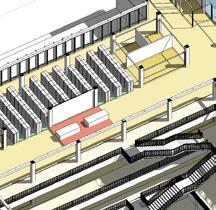



















Moffitt Library
UNIVERSITY
OF CALIFORNIA | BERKELEY, CALIFORNIA

BNIM is working with the University of California, Berkeley to create a project program for the initial phase of a full renovation of the first through third floors of Moffitt Library. UC Berkeley’s 32 constituent and affiliated libraries together make Moffitt the fourth largest university library by number of volumes in the United States — surpassed only by the libraries of Harvard, Yale, and the University of Illinois at Urbana-Champaign. Opened in 1970 as a cutting-edge library for undergraduates, Moffitt Library rejected the neoclassical tradition of most campus buildings. At five-stories and constructed of cast-in-place concrete, Moffitt Library is uniquely situated within memorial glade, partially below grade with building entry points at the third floor. In 1994, Gardner Stacks, a four-story underground addition connecting Moffitt to the historic Doe Library was completed, where more than 2.5 million volumes are stored within four acres of space.
In 2016, the University began re-envisioning Moffitt Library with the renovation of floors 4 and 5, comprising approximately 38,000 SF. This initiated the transformation of the library to interactive and dynamic modes of learning and research. A stated goal of the University is that the renovation of floors 1, 2, and 3, comprising of approximately 100,000 SF, should “both capitalize and improve on the foundations presented by the work on floors 4 and 5 toward the creation of a flexible yet culturally and aesthetically harmonized facility.” Through our current work on major library renovations at both Georgia Tech and Cal Poly San Luis Obispo, we are seeing a reinvention of the library system that focuses on the revitalization of historic structures to reposition libraries as contemporary centers for discovery and innovation.gy come together in an experiential learning environment.


















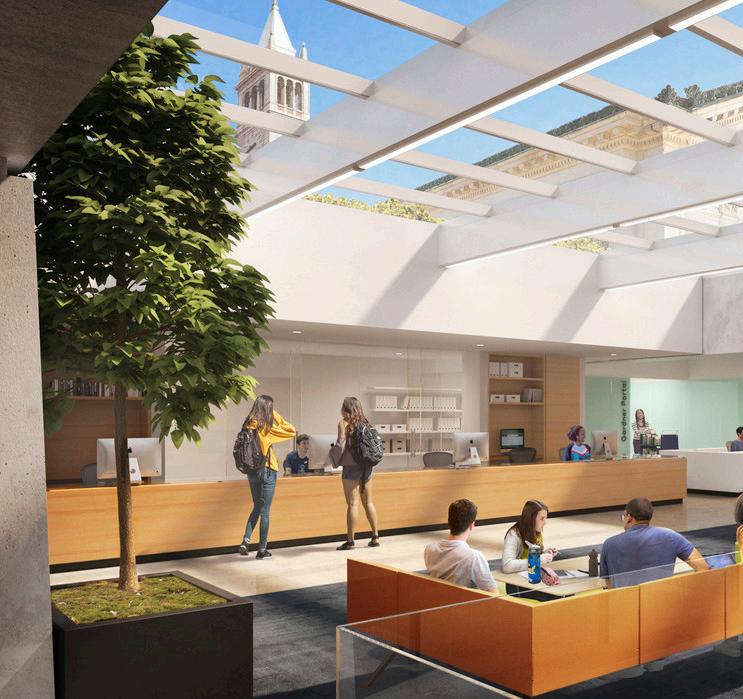

Medical Education and Biomedical Library Study
THE UNIVERSITY OF CALIFORNIA, LOS ANGELES
LOS ANGELES, CA


BNIM led a comprehensive design team to develop a new building for the David Geffen School of Medicine at UCLA, which will establish a new gateway for the Health Sciences campus, create a front door for the School of Medicine (SOM), and integrate the new building with existing facilities to provide greater campus connectivity and new outdoor spaces. The team developed a Design Brief that includes a space program for the School of Medicine and Library functions, a master plan for the Health Sciences campus precinct, and a conceptual design for a new building in conjunction with the repurposing of an adjacent, existing structure for the Biomedical Library, which will serve the entire campus.
The space program for the new SOM facility includes classrooms and seminar rooms, multi-purpose teaching laboratory space, study and amenity space for students, administrative offices and related building support space.
The plan creates new outdoor spaces to promote campus community and interprofessional activities, including a future Tiverton Health Sciences Commons, planned as a largely pedestrian outdoor space adjacent to the Botanic Garden, which will connect the front doors of the Schools of Medicine, Dentistry, Public Health and Nursing. The new commons relates directly to the newly renovated Court of Sciences due north in the heart of the main campus. The master plan includes a second new outdoor, public space north of the new building and east of the new library
157,223 SF
Completion in 2011
Jannes Library
KANSAS CITY ART INSTITUTE
KANSAS CITY, MISSOURI


Nested atop a treed hill slope, the Jannes Library and Learning Center—an addition to a 1912 Georgian style mansion on the Kansas City Art Institute campus— maximizes site configurations, while providing ease of access for pedestrians and vehicles alike. The new addition was designed to respect the existing structure by not trying to mimic its architecture or compete with its street presence. By contrasting the new from the old, both structures are able to retain their separate integrities and are true to their time and construction methods. The existing brick structure houses three departments—Library, Academic Center and Computer Lab—while the new addition solely contains library functions.
The new addition embodies the concept of the “containment of knowledge.” The shell of the addition, in respect to the human anatomy, becomes a structural “cranium” for the knowledge contained within the library stacks. ‘Knowledge’ is embodied in physical form through books and computers. Perimeter reading and study spaces throughout the building are an important amenity. The overall result culminates in an environment of higher learning and education that promotes interaction.
21,000 SF Completion in 2002







2003 AWARD FOR REHABILITATION
Historic Kansas City Foundation
2002 DESIGN MERIT AWARD
AIA Kansas City
2000 HONOR AWARD, UNBUILT CATEGORY
AIA Kansas City
1998 MONSTERS OF DESIGN - MERIT AWARD
AIA Young Architects Forum (YAF)

Kansas City Public Library and Children’s Center – Plaza Branch

The library is part of Plaza Colonnade, a mixed-use project created through an innovative public-private partnership. The library offers more of what the community has been asking for: more information, space, programs and technology. Features such as a children’s center, a 350-seat auditorium and a four level parking garage with 200 spaces just for library patrons make the library a vital community asset.
The Plaza Branch Library changes the public perception of libraries. The facility is an ‘information playground,’ one that has both the traditional elements of a library and the technology to adapt to the future. It offers something special for children and their parents, students and their teachers, community members and their visitors.
50,000 SF Completion in 2005














